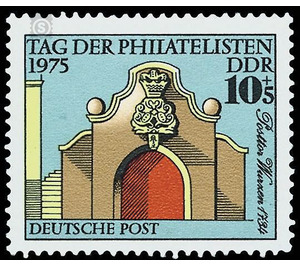Day of the philatelists - Germany / German Democratic Republic 1975 - 10 Pfennig
Theme: Architecture
| Country | Germany / German Democratic Republic |
| Issue Date | 1975 |
| Face Value | 10.00 |
| Color | multi-colored |
| Perforation | K 14 |
| Printing Type | Rotogravure 2 |
| Stamp Type | Postage stamp |
| Item Type | Stamp |
| Chronological Issue Number | 1836 |
| Chronological Chapter | GER-DDR |
| SID | 919193 |
| In 19 Wishlists | |
To the day of the Philatelisten 1975 To the day of the Philatelisten 1975 the Ministry for post office and telecommunications of the German Democratic Republic gives out two multicolored special postage stamps, of it one with surcharge. The sums collected will be made available to the Philatelistenverband in the cultural association of the GDR. Philatelist Day 1975 The friends of the stamps and other postal documents commit their "Philatelic Day" for the ninth time in 1975, this time falling on the 26th of October. When he replaced the hitherto traditional "Stamp Day" in 1967, this was more than an outward name change. Rather, the view of the subject of philatelic hobby was directed more strongly than before to the benefit that this valuable cultural activity can bring the collector, a benefit that the principles of the Philatelistenverbandes in the Cultural League of the GDR as a contribution to the further expression of socialist personalities and to call a socialist way of life. It is also in this direction if the day will be characterized by a thematic philatelic, which, as one of the possible forms of collecting, is particularly suited to treat all areas of nature and society and to present them in political, economic, to comment on ideological and cultural issues. To support the cultural policy concerns of the Philatelistenverbandes the Ministry of Posts and Telecommunications of the GDR brings out regularly special stamps for years, 1975 again document the close relations between philatelic and post by showing a historic and a modern post-construction. 10 + 5 Pfennig: Old Post Gate to Wurzen The post-gate, built in 1734 in Baroque style at the instigation of the postmaster Johann Michael Lindner in Wurzen, is still today a representative landmark of the Electoral Post Office in addition to the well-known postmilitary pillars. It is the only surviving building of its kind and enjoys state conservation. After severe weathering damage threatened the gate, extensive restoration work began on 1974 on the initiative of the research group "Kursächsische Postmeilensäulen" of the Philatelistenverband in the Cultural League of the GDR, which will be completed later this year. The archway was demolished and rebuilt at its original height after roadworks had changed its appearance in the past. The ornaments attached to it in the form of a crown and two coats of arms, the electoral-Saxon and the Polish-Lithuanian, were newly created by the sculptor Herbert Geist from Dresden and receive at the end of the work a faithful gilding and colored version. The historic post gate is located in Wurzen am Crostigall and points out with the number "3" in the keystone that Wurzen to Meissen and Oschatz was the third horse changing station on the once most important post road from Dresden.


